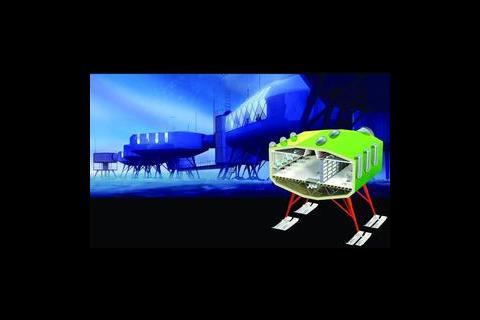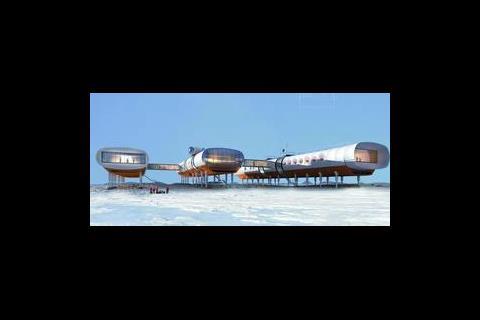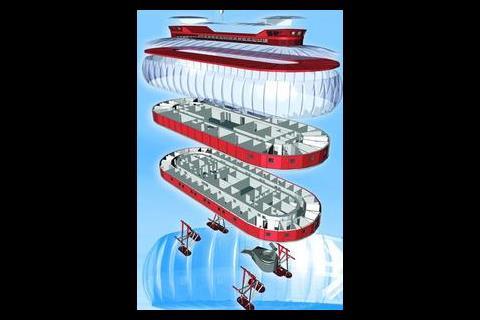The conditions are hostile, the timing is tight and it’s a long way from home, but three teams are eagerly fighting for the right to build the British Antarctic Survey’s research station – and their designs all have one thing in common.
It’s the distance you are from civilisation that makes this project unique, says Malcolm Reading. As architectural advisor to the British Antarctic Survey, he knows just how big a challenge the construction team will face when it comes to building Halley VI, BAS’s new research station on the Brunt Ice Shelf. “If something breaks or goes wrong you can’t pick up the phone and get an extra flight to come down with spares or replacements,” he explains.
“And that’s the big difference compared with building in somewhere like northern Canada, where the conditions are still extreme but the supply line is much easier.”
Halley VI will be the latest in a line of research stations built and occupied by BAS in the Antarctic, from where it undertakes key scientific studies. It was from here in 1984 that the hole in the ozone layer was first detected. In 2004, with its current station nearing the end of its useful life, BAS began work on a replacement and set in motion an architectural competition with the RIBA. Of the 86 original entrants, there are now three concepts that are being worked up in more detail.
The one common thread that runs through all three schemes is the use of prefabrication. As Ed McCann, associate director of Expedition Engineering, one of the three shortlisted teams, explains: “Prefabrication is clearly not novel for BAS. It is driven by the desire to avoid works on site because it is cold, it reduces commissioning requirements and minimises the chance of anything going wrong.“
The Antarctic is a place of extremes. It is the coldest and windiest continent, with temperatures dropping to -55°C in winter and winds reaching up to 150 km/h. And it’s not just the problem of extreme cold that the teams have to consider, says Reading. “When they load up the ship, the containers will more than likely have to pass through the tropics before they get to the Antarctic, so they must be designed for all extremes of temperature and humidity.”
Building anything on the Brunt Ice Shelf will rely on taking supplies in by ship – flying in is impractical as a result of the limited payloads, the cost of fuel and the changeable weather. However, it’s only in the short summer months that the ice-strengthened ship is able to get through the sea ice and moor close enough to the shelf to unload supplies.
BAS’s plan is that Halley VI will be constructed in two stages during the 10-week austral summers in 2008 and 2009. “The crucial thing is that you have got a very short period of time when you can deliver whatever you are going to build,” says Reading. “It’s a period that at best lasts three months, and is another reason why prefabrication is crucial.”
The station will operate year round, accommodating up to 52 scientists and support staff in the summer months, reducing to 16 over the winter, and will comprise domestic, technical and scientific facilities including a medical surgery and leisure facilities.
On previous stations BAS has used a mixture of flat pack (Ikea-style) construction assembled on site and fully serviced containerised plant rooms, with mixed success. “We decided there were benefits to be gained by taking it a step further and moving from flat pack to fully fitted-out containers,” says McCann, who describes Expedition Engineering’s scheme as an evolution of a military hospital. The concept, created with Hopkins Architects, is for a pair of two-storey buildings constructed of standardised modules, the dimensions of which fit within ISO freight containers (6.1 m × 2.44 m × 2.9 m). “We decided to adopt the international container standards to simplify the whole shipping process,“ says McCann. “It enables you to use standard freight handling kit and avoids the expense of specialist lifting gear. Otherwise I think this approach would be implausible.”
With the type of ships on hand, the volume of freight isn’t a defining limit; what is is the strict obligation it puts on the designers in terms of spatial planning. “What you lose in design terms is flexibility and spatial planning,” says McCann. “You have to stick to the volume defined by the module and do everything within it.”
The buildings would use a semi-monocoque structure, similar to an egg box, to get maximum strength with the minimum weight. The walls, ceilings and floors of the containers will double up as stiff structural plates. When bolted together the containers will become a single structure, stiffened internally using bulkheads and floor plates.
Another reason for using ready-made modules is minimising time on site. McCann reckons their scheme could even be built in one push. “Two things you need to do it in a single season are to get in early, which would require using an ice breaker rather than the ice strengthened ship normally used, and substantially fitted out modules.” The already tight construction programme is further shortened by the time it takes contractors to set up their own accommodation for the stay on site. McCann says the use of substantially fitted-out modules is a way around this. “Normally a couple of weeks of the season are lost getting the accommodation together. With already fitted-out modules they can place them on the ground wire them up to a generator and live in them.”
Faber Maunsell and Hugh Broughton’s design for the research station uses a “plug and play” approach. A series of semi-autonomous modules containing sleeping accommodation, offices, workshops and power plant are connected via circulation hubs to a 200 tonne “mother ship”, which encloses the social spaces. “Apart from supporting the science, the station is primarily a survival module similar to the lunar excursion module used by NASA in the 1970s, only ours is bigger, assembled in situ and isolated every year for 10 months during the austral winter,” says Michael Maslin, regional director of Faber Maunsell. “We’re proposing to build off site the underbelly with the legs and skis attached and pre-install what services we can,“ he explains. “But we’re conscious of the weight limitation.”
Weight is the weak link in the supply line. The first stop for any supply ship – South Africa and Brazil are potential manufacturing bases for prefabricated modules – would be BAS’s base in Rotherer, one of the few places not ice bound all year round. From here any ship would make its way across the Weddell Sea and moor on the sea ice as close to the ice shelf as possible. Supplies would then be unloaded onto the sea ice and transported on sledges pulled by Snow Cats to the base. However, at only 1-2 m thick, the sea ice can support a maximum weight of six tonnes, which places a strict limit on the size of any modules.
Faber Maunsell proposes towing the sealed space frames across the sea ice on their own skis. Steel portal frames would be lifted into locating sleeves and prefabricated preglazed external side panels screw fixed to the steel frame from within the module. No glued connections are used because of the temperatures and panel sizes are limited to 3 m to allow man-handling and to minimise the risk of panels being caught by the wind – any lost or damaged sections would take eight months to replace. Bathrooms and utility rooms would be delivered as pre-finished and sealed pods and lifted into position before the entire building is clad in a protective outer skin.
“BAS likes low-tech materials; wood is particularly popular because it doesn’t contract and can be repaired,” explains Maslin. Composite cladding panels built up from closed cell foam and plywood are currently being assessed. “You need a very good internal vapour barrier to stop moisture from occupants going into the cellular foam as interstitial freezing has been a problem in the past.”
The entire construction process will also need to be kept low-tech, with as much commissioned before it is shipped to site as possible. “We can’t afford to design something that has to have one particular specialist to construct,” says Maslin. “You can’t have someone sitting around for six weeks because he is waiting for his two weeks of activity.”
To help provide a sheltered workplace during construction, Buro Happold and Lifschutz Davidson’s are proposing a twin cladding system for its series of three, two-storey independently serviced “ice craft”. These are split into winter accommodation and science labs, a social craft, and summer accommodation that can be mothballed during winter months or used in case of fire or emergencies. Each ice craft will have a similar structure, consisting of a ribcage of curved beams that enclose the upper deck supported on a rigid chassis.
The 12 m × 24 m upper deck of each craft will be uninterrupted by structure or services, to maximise flexibility. The lower deck and base is formed of a rigid trussed box and provides services to the upper deck, including fresh air, heating and cooling, water, power and drainage.
It is envisaged that the outer skin of soft translucent fabric, made of Teflon-coated glass fibre, would be quick to erect, providing shelter and allowing insulated aluminium sandwich panels to be erected from the inside of the upper deck. In the long term, the outer skin will act as a weather shield keeping wind and snow off the interior skin and reducing air leakage and heat loss.
Services
Halley VI must operate with minimal environmental footprint and fossil fuel consumption – and at the end of its 20-year design life the component parts must be capable of being removed to meet the legal requirements of the Antarctic Treaty.
Currently, aviation-fuelled CHP plant is used. Expedition Engineering’s McCann says it is proposing multiple small CHP generators. “What BAS wished they’d done first time around is double the number they’ve got and half the size for load matching,” he says. “CHP is a problem down there because it dumps to the atmosphere most of the time because
they can’t use all the heat.” The plan would be to maximise the amount of testing and pre-commissioning before the packaged units are taken to site.
Faber Maunsell is proposing energy modules to tie in with its modular concept. “These are smaller than the standard modules and will house generators and dirty plant such as the pumping systems,“ says Maslin. In BAS’s current building, the generators are on the same platform, so you have the droning of the generators, diesel smells, vibration and a fire risk.
“We feel that by putting them in a separate module we can eliminate these.” The modules would have electrical and water connections to the main station, but the engine itself would be isolated.
The Faber Maunsell design also attempts to reduce the number of components used. “We’re looking at rationalising the CHP generators to one common size,” Maslin says. “Similarly, a lot of the services will be designed in such a way that we are going to significantly reduce the amount of spares necessary, such as rationalising the different sizes of isolation valves used.”
While BAS is keen not to be prescriptive, it does want to avoid anything too radical in terms of components and materials. “You don’t want to be in situation where something doesn’t work,” says Reading. “The strategy we will be following with the teams is to build in ideas that become working experiments. We’ll trial them to see if they work.”
Generally, the shortlisted teams will be trying to use recognised, tried and tested technologies from other industries, such as food waster composters – common to fast food outlets – to reduce the volume of waste that has to be shipped back off the ice shelf.
Other technologies that might be trialed include photovoltaics and small wind turbines, although with long periods of darkness and gusting winds their effectiveness may be limited. More radical are propositions to use biodigesters for human waste and hydroponics to grow lettuces and salads – the lack of fresh fruit and vegetables is one of the biggest complaints.
With a project value of £26m, standardisation will also be important from an economical point of view. Faber Maunsell, for example, has been in discussions with manufacturers about the flexible connections used to link its modules. “We went to see a manufacturer who produces connections for railway carriages. Interestingly, they produce that product for railways in Alaska and Finland, which are not massively different to the temperatures we’re talking about and they have a product which with very little or no adaptation would be ideal for here.”
The next stage will be to get contractors, with experience of working in extreme conditions, on board to explore the buildability, testing, commissioning and logistical issues. “There’s a very limited number of specialists companies who can do this work,” says Reading. “But contractors will bring different innovations such as packaging and waste management.”
Testing facilities are also being sought. “We’re looking at testing in northern European climate zones, Greenland and north Norway, where we think we can get the right conditions to test but that are much more accessible,” says Reading. In addition this will give contractors the opportunity to carry out trial erections and discover any potential problems or improvements that can be made.
The decision on which design gets the go-ahead will be made in the later this year. “When we select the final design we’ll then enter into a partnering contract of some variety,” says Reading. For one of the teams this will mark the beginning of an adventure.
Antarctica: facts and figures

- Antarctica is more than 58 times the size of the United Kingdom.
- The icecap contains almost 70% of the world’s freshwater and 90% of its ice.
- The Brunt Ice Shelf is a 150 m thick floating extension of the grounded ice sheet that flows at a rate of 0.4 km per year north-west from Coats Land towards the sea where it calves off as icebergs.
- Temperatures range from -55°C in the winter to +4.5°C during the summer.
- Wind conditions vary from periods of absolute calm to days of continuous storm.The extreme mean hourly wind speed is approximately 100 km/h with extreme gust speeds up to 150 km/h.
- There is 24 hour daylight during the Antarctic summer and darkness for 55 days in winter. The sun does not appear above the horizon for 100 days a year.
- On average, snow falls 175 days a year on the Brunt Ice Shelf, accumulating to 1-1.5 m deep. Rain has never been reported.
- Sea ice is frozen seawater that forms around the continent in the autumn, as a floating layer only a few metres thick. Most of it melts during the summer.

“The trip to Halley V started with a stay at another of the British Antarctic bases, Rothera on the north-west peninsula. The 1000 mile trip from Rothera to Halley was by light aircraft and gave a glimpse of this vast and unforgiving continent.
“It’s cold at Halley and we regularly had to wrap up in five layers of clothing just to survive outside and avoid frostbite. But the weather from one day to another is never the same. It can be blowing a gale one day and be sunny and calm the next – it’s so unpredictable. The sun’s radiation is very powerful, partly as a result of the lack of ozone, so everyone had to put sun cream on before going outside, even at night – that’s because it’s summer at the moment so the sun never sets.
“The scenery at Halley is what I imagined of the Antarctic – a vast, flat desert of snow and ice that stretches for as far as you can see. There is some outside sport played here – football matches, the odd game of golf and kite skiing – and socialising is important; spare time is often spent in the bar, watching a film in the lounge, or working out in the gym.
“The 12,000 mile trip back to the UK took us via several other stations – the Swedish base, the German base and finally Novo, operated by the Russians, who will flew us off the continent to South Africa. Visiting so many bases in one short trip is almost unheard of, but I now have a great understanding of what is needed for the next British base, as well as a few very interesting stamps in my passport.”
Source
Building Sustainable Design























No comments yet